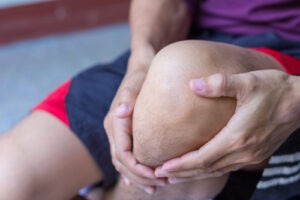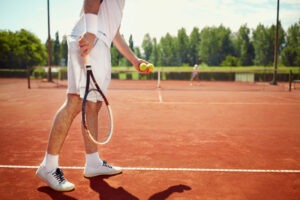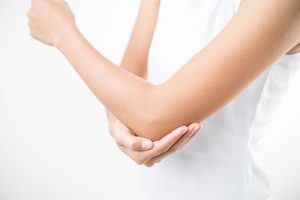 Anterior cruciate ligament (ACL) injuries are a significant concern for athletes and physically active individuals. The ACL is a vital structure that links the thigh bone to the shinbone, playing a key role in stabilizing the knee joint. Injuries to the ACL typically occur during high-impact activities that involve sudden movements, such as abrupt stops, jumps, or swift changes in direction. Sports like soccer, basketball, and skiing are common settings for these injuries. When the ACL is compromised, it can result in knee instability and impaired mobility. Understanding the causes and implications of ACL injuries is essential for both prevention and effective treatment. At the practice of Steven C. Thomas, MD and Donald W Pennington, DO, our board-certified surgeons specialize in orthopedic procedures in the Las Vegas area.
Anterior cruciate ligament (ACL) injuries are a significant concern for athletes and physically active individuals. The ACL is a vital structure that links the thigh bone to the shinbone, playing a key role in stabilizing the knee joint. Injuries to the ACL typically occur during high-impact activities that involve sudden movements, such as abrupt stops, jumps, or swift changes in direction. Sports like soccer, basketball, and skiing are common settings for these injuries. When the ACL is compromised, it can result in knee instability and impaired mobility. Understanding the causes and implications of ACL injuries is essential for both prevention and effective treatment. At the practice of Steven C. Thomas, MD and Donald W Pennington, DO, our board-certified surgeons specialize in orthopedic procedures in the Las Vegas area.
Recognizing the Signs
Recognizing the symptoms of an ACL injury is essential for timely intervention and recovery. Common signs include a loud pop or a “popping” sensation in the knee at the time of injury, which can be both audible and felt. Severe pain often follows immediately, making it difficult to continue with physical activities. Rapid swelling is another key indicator, usually developing within the first few hours post-injury.
Individuals may experience a loss of range of motion, which can manifest as stiffness or an inability to fully straighten or bend the knee. Additionally, the injured knee may feel unstable or give way, especially when putting weight on it or trying to walk. Bruising around the knee might also appear a few days after the injury, further signaling internal damage.
It’s not uncommon for some people to initially mistake the severity of an ACL injury, especially if they are able to bear weight shortly after the incident. However, persistent discomfort and instability are strong indications that medical evaluation is necessary. Ignoring these symptoms can result in further complications, such as damage to other knee structures like the meniscus or cartilage.
If you suspect an ACL injury, it’s crucial to cease any activities that stress the knee and apply ice to reduce swelling. Elevating the leg and using compression bandages can also help manage initial symptoms. Over-the-counter pain relievers may offer some relief, but they should not replace professional medical advice.
Immediate medical attention is vital to accurately diagnose the injury and initiate appropriate treatment. A healthcare provider can perform physical tests and imaging studies to confirm the diagnosis and assess the extent of the damage. Prompt diagnosis not only aids in effective treatment but also helps prevent long-term issues, such as chronic knee instability and osteoarthritis.
Recognizing and addressing the early signs of an ACL injury can significantly influence the recovery process and long-term outcomes, making awareness a critical first step.
Diagnosis Procedures
The initial step in diagnosing an ACL injury involves a thorough physical examination. During this examination, the doctor assesses the knee for signs of swelling, tenderness, and limitations in movement. Specific tests, such as the Lachman test or the pivot shift test, are often used to evaluate knee stability and the integrity of the ACL.
To gain a clearer understanding of the injury, imaging tests are crucial. Magnetic Resonance Imaging (MRI) is particularly valuable as it provides detailed images of the knee’s soft tissues. An MRI can reveal the extent of the ACL tear and identify any additional damage to surrounding structures, such as the meniscus or cartilage.
In some cases, X-rays may be ordered to rule out fractures or other bone-related issues. Although X-rays cannot visualize soft tissues like ligaments, they are helpful in providing a comprehensive overview of the knee joint.
Following the imaging tests, the doctor will compile the results to confirm the diagnosis and determine the severity of the injury. This information is critical for developing a tailored treatment plan that addresses the specific needs and goals of the patient.
Treatment Options
Treatment for ACL injuries can vary widely based on several factors, including the severity of the tear, the patient’s level of physical activity, and their personal objectives. For individuals with partial tears or those who are not highly active, non-surgical options might be sufficient. Physical therapy is a primary treatment in such cases, focusing on strengthening the muscles surrounding the knee and enhancing overall joint function. This approach can often help stabilize the knee and improve mobility without the need for surgical intervention.
However, for patients with complete ACL tears or those who wish to return to high-demand sports or physically intensive activities, surgical options are often necessary. Orthopedic surgery to reconstruct the ACL typically involves replacing the torn ligament with a tissue graft. This graft can be sourced from the patient’s own body, often from the hamstring or patellar tendon, or from a donor. The surgery is generally performed arthroscopically, which means it involves small incisions and the use of a camera to guide the surgeon, making it less invasive and reducing recovery time.
Post-surgery, patients undergo a comprehensive rehabilitation program that aims to restore knee function and strength. Physical therapy plays a crucial role in this phase, with exercises designed to gradually increase the knee’s flexibility, stability, and strength. The rehab process can last from six to nine months, depending on the individual’s progress and adherence to the prescribed regimen.
In some cases, patients may also use knee braces to support the joint during recovery, although this is usually a temporary measure. Pain management strategies, including medications and possibly ice application, are also employed to help manage postoperative discomfort.
For active individuals, particularly athletes, the goal is to return to their previous level of activity. This often involves sport-specific training towards the end of the rehab program to ensure that the knee can handle the stresses and strains of high-impact activities. Each treatment plan is personalized to cater to the patient’s specific needs, ensuring the best possible recovery outcome.
What to Expect from Surgery
For those preparing for orthopedic surgery to address an ACL injury, it’s crucial to have a clear understanding of the various stages involved. Before the procedure, patients may be recommended to engage in preoperative physical therapy. This preparatory phase aims to reduce swelling and improve knee mobility, setting a solid foundation for post-surgical recovery.
On the day of the surgery, the procedure typically begins with the administration of anesthesia to ensure the patient is comfortable and pain-free throughout. The surgery itself is often done using arthroscopic techniques, which involve making small incisions around the knee. Through these incisions, the surgeon inserts a tiny camera and specialized instruments to visualize and repair the damaged ACL. This minimally invasive approach generally leads to a faster recovery and less postoperative pain compared to traditional open surgery.
The main objective of the surgery is to reconstruct the torn ligament using a tissue graft. This graft can come from the patient’s own body, commonly from the hamstring or patellar tendon, or from a donor. The choice of graft type is usually based on the patient’s condition and the surgeon’s recommendation.
Once the ligament is reconstructed, the incisions are closed, and the patient is moved to a recovery room for monitoring as the anesthesia wears off. Immediate postoperative care involves managing pain and swelling, often through medications and the application of ice packs.
The initial phase of recovery is focused on protecting the new ligament and gradually restoring knee function. Patients are typically advised to use crutches for a few weeks to avoid putting weight on the affected leg. Physical therapy usually begins shortly after surgery, with a program designed to gradually restore flexibility, strength, and stability to the knee. This rehabilitation phase is crucial for a successful recovery and can take anywhere from six to nine months.
Throughout this period, regular follow-up appointments with the surgeon and physical therapist are essential to monitor progress and make any necessary adjustments to the rehab program.
Preventing ACL Injuries
Preventing ACL injuries involves a combination of targeted exercises and proper techniques. Strengthening exercises for the quadriceps, hamstrings, and core muscles are vital for providing better support to the knee joint. Incorporating agility drills, such as ladder drills and cone drills, helps enhance coordination and reduce the risk of sudden movements that might cause injury. Balance exercises, including single-leg stands and use of balance boards, can also improve stability.
Proper techniques when jumping and landing are crucial. Athletes should focus on landing softly with bent knees and avoiding inward knee movement. Wearing appropriate footwear that provides adequate support and grip can also help prevent ACL injuries, particularly in high-impact sports.
Education and training programs that focus on improving movement patterns have proven effective in reducing the risk of ACL injuries. These programs often include a combination of strength training, plyometrics, and flexibility exercises. Additionally, athletes should be encouraged to maintain a balanced training regimen that includes rest periods to prevent overuse injuries.
Incorporating these strategies into regular training routines can significantly lower the likelihood of sustaining an ACL injury. Regular assessments by trainers or physical therapists can help ensure that exercises are performed correctly and effectively. By taking these proactive steps, athletes and active individuals can better protect their knees and maintain their physical health.
Contact Surgeons Dr. Thomas and Dr. Pennington at the Knee and Shoulder Institute in Las Vegas, NV to Schedule an Appointment:
If you would like to schedule an appointment or learn more about the Knee and Shoulder Institute procedures & treatments,contact the office today click here.
Serving patients from and around greater Las Vegas, Lake Havasu, Bullhead City, Mesquite, Pahrump, Nevada
 Shoulder impingement is a common cause of pain and limited mobility, especially for athletes, manual laborers, and individuals who perform repetitive overhead movements. This condition occurs when the tendons of the rotator cuff become pinched between the bones of the shoulder, leading to inflammation, irritation, and discomfort. Understanding the symptoms, causes, and treatment options can help you seek care early and avoid long-term damage. At the practice of Steven C. Thomas, MD and Donald W Pennington, DO, our board-certified surgeons specialize in orthopedic procedures in the Las Vegas area.
Shoulder impingement is a common cause of pain and limited mobility, especially for athletes, manual laborers, and individuals who perform repetitive overhead movements. This condition occurs when the tendons of the rotator cuff become pinched between the bones of the shoulder, leading to inflammation, irritation, and discomfort. Understanding the symptoms, causes, and treatment options can help you seek care early and avoid long-term damage. At the practice of Steven C. Thomas, MD and Donald W Pennington, DO, our board-certified surgeons specialize in orthopedic procedures in the Las Vegas area.

 Musculoskeletal pain and injury are common—but not every ache needs a trip to an orthopedic surgeon. So how do you know when to see a specialist? In this blog, we outline key signs and symptoms that suggest it’s time to consult an orthopedic expert.
Musculoskeletal pain and injury are common—but not every ache needs a trip to an orthopedic surgeon. So how do you know when to see a specialist? In this blog, we outline key signs and symptoms that suggest it’s time to consult an orthopedic expert.  Navigating orthopedic care can raise many questions. Here, we answer some of the most frequently asked questions about orthopedic health, injuries, and treatments.
Navigating orthopedic care can raise many questions. Here, we answer some of the most frequently asked questions about orthopedic health, injuries, and treatments.  Physical therapy (PT) is a cornerstone in the recovery process for sports injuries. Whether you’re an elite athlete or a weekend warrior, proper rehabilitation ensures a safe return to activity while minimizing the risk of reinjury. In this blog, we discuss how physical therapy supports healing, restores function, and helps athletes regain their performance.
Physical therapy (PT) is a cornerstone in the recovery process for sports injuries. Whether you’re an elite athlete or a weekend warrior, proper rehabilitation ensures a safe return to activity while minimizing the risk of reinjury. In this blog, we discuss how physical therapy supports healing, restores function, and helps athletes regain their performance.  Ligaments play a vital role in stabilizing joints, and in the elbow, the ulnar collateral ligament (UCL) and radial collateral ligament (RCL) are key to maintaining proper movement and function. Injury to these ligaments—whether from overuse, trauma, or sports—can result in elbow instability, pain, and limited function. In this blog, we explore how UCL and RCL injuries occur, their symptoms, and treatment options.
Ligaments play a vital role in stabilizing joints, and in the elbow, the ulnar collateral ligament (UCL) and radial collateral ligament (RCL) are key to maintaining proper movement and function. Injury to these ligaments—whether from overuse, trauma, or sports—can result in elbow instability, pain, and limited function. In this blog, we explore how UCL and RCL injuries occur, their symptoms, and treatment options. 

